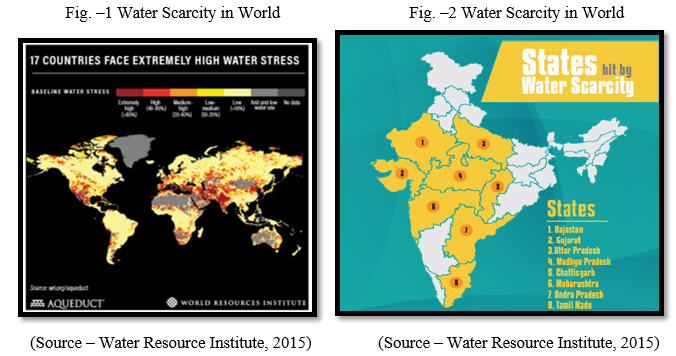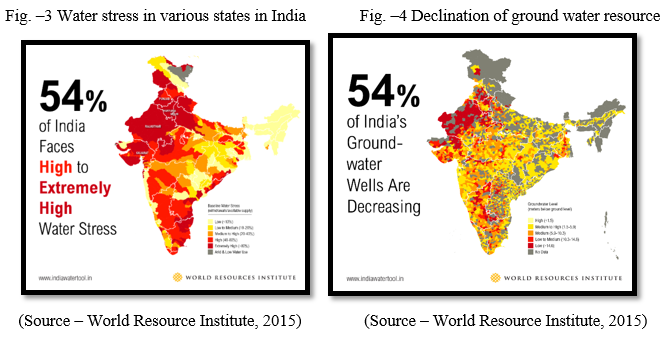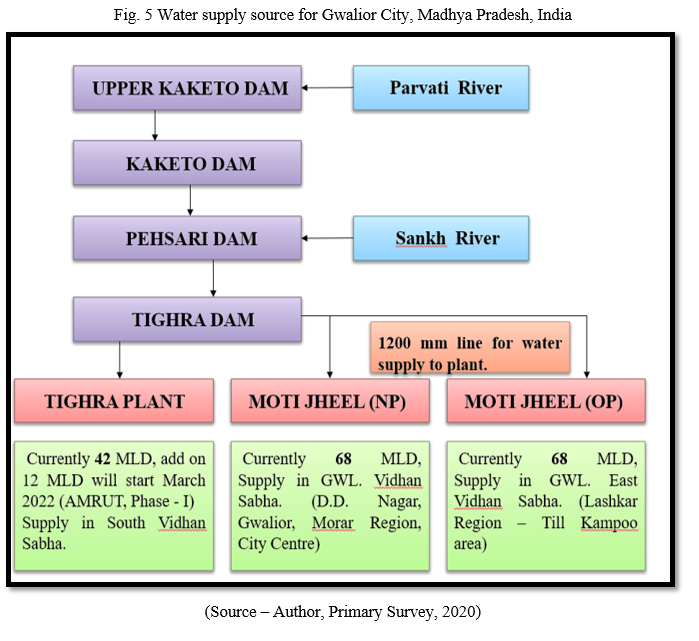Ijraset Journal For Research in Applied Science and Engineering Technology
- Home / Ijraset
- On This Page
- Abstract
- Introduction
- Conclusion
- References
- Copyright
Water Management Issues in Indian Cities: Case Study of Gwalior, Madhya Pradesh, India
Authors: Ar. Dilip Singh Kushwaha, Dr. Ila Gupta, Dr. M. K. Hassan
DOI Link: https://doi.org/10.22214/ijraset.2022.40186
Certificate: View Certificate
Abstract
Urban development has a substantial role for depleting and polluting surface water sources along with contamination of ground water sources. It creates several uncertain circumstances due to reduction in quantity of water and this land become barren on surfaces. As a result, people started to encroach it, which further impact on water bodies in undesirable way. These water bodies are anguish due to continuous pollution and change the way of treatment of urban water bodies, even government also converted these water bodies and rivers in to drain and area for dumping garbage. These are also miss used by local communities for many purposes like open defecations, occasionally these are used for immersion of idol due to lack of facilities and other reasons too. Besides all of these Industrial effluents, run off from nearest agricultural fields, refuse from sewage and other domestic wastes provide a nice platform for eutrophication. (http://spaenvis.nic.in/index1.aspx?) Now everyone is worried about the potential water scarcity in the face of increasing, mainly population-driven, water demands, and its consequences on our energy and food production. The Over 900 recognized professionals conducted a survey for under the heading “Global Risk Perception Survey”, it is directed by the World Economic Forum. They found that reports that the highest level of common impact over the next 10 years will be from water crises. (http://www3.wefo-rum.org/docs/WEF_Global_Risks_2015_Report15). So, this paper is an attempt to see challenges in Indian fast-growing cities and how we can manage water resource those are engulfed by rapid urbanization. Principally focused on the depleted source and characterize their conditions.
Introduction
I. INTRODUCTION
India has 17.14 percent of the worlds population while India has only 2.45 percent of the world resources and 4.5 percent of fresh water resources. (Ministry of Water Resources, December 2008). In 2011, for the first time since independence, the Census revealed that the absolute increase in population in urban areas was more than that of rural areas, and the urban population is expected to grow to 590 million by 2030. The proportion of urban population to overall population increased from 27.81 per cent in 2001 to 31.16 per cent in 2011 Census (Census of India, 2011). Out of the total 370 million inhabiting urban India, 65.4 million were slum dwellers (Dashi, 2013).
An increasing population and inadequate surface water is fast depleting the country of its groundwater resources. More than a third of the country's population lives in water-stressed areas. (Gurman Bhatia,2019) As we already know water is an essential element for every living body on Earth. Global availability of fresh water on earth are not equally distributed all over in world. Beside this fact, global supply of available freshwater is more than enough to meet daily water demands. India is having a variety of climatically and geographically zones. As a result, availability of water resources depends on various parameters for that particular region like precipitation, altitude and proximity to natural water resource. This also include ground water resource. Major impacts of water scarcity are visible in urban or city region due to many factors like rapid urbanization, inadequate ground recharge, large areas of are having hard space, encroaching natural resource, improper storm water drainage etc. These are some common or similar challenges and issues in Indian cities. In such areas, the lack of adequate clean water to meet human drinking water and sanitation needs is indeed a constraint on human health and productivity and hence on economic development as well as on the preservation of a clean environment and healthy networks. Despite of all challenges of fresh water resource and issues, many cities are having a good amount of water resource but due to lack of proper management those cities and areas are facing problem for water and sanitations. So, we can find many cities are in India are facing problem of flood or flood like situation even they are facing problem of water scarcity due to less precipitation. There is a third category also in Indian cities which facing problem for fresh water and flood or flood like situation as well. Gwalior is also come one of the categories who are having both challenges. This paper identifies the issues and challenges facing for water management today and future research needed to better management techniques and practice for sustainable and desirable future.
A. India: Water Crises and Potential Threats
Chennai is officially declared as zero ground water city, we can define the ground water is so deep so its not feasible to take out ground water economically and environmentally as well. In the year 2020, the National Institution for Transforming India (NITI Aayog), which government research organization and mainly look after planning and development parts. They stated that soon Indian cities will face “suffering from the worst water crisis in its history, and millions of lives and livelihoods are under threat.” Aqueduct’s findings put this disaster in context: India ranks 13th for overall water stress and has more than three times the population of the other 17 extremely highly stressed countries combined. (Water Resource Institute, 2020)
The new water research data includes both surface urban water sources and groundwater sources in deep stress for the first time. Along this we can identified to rivers, lakes and streams, India’s groundwater resources are severely over limit, mainly to provide water for irrigation. Groundwater tables in some northern part of India, aquifers declined at very high rate, it is 8 centimeters per year from 1990-2014. (Water Resource Institute, 2015)
India is beginning to take serious steps to mitigate water stress, including setting up the Jal Shakti Ministry to prioritize all water issues—including supply, drinking water and sanitation—under one national government umbrella. We can create different types of solutions so that country can pursue include more well-organized irrigation; conserving and restoring lakes, floodplains, and groundwater recharge areas; and collecting and storing rainwater.

Figure 3 and 4 are outcome of India Water Tool Version 2 (IWT 2.0), which is an online tool for companies and other users to understand their water-related risks. So that they are able to prioritize actions related water management in future. IWT 2.0 combines data from Indian government agencies and water stress indicators from WRI and Columbia Water Centre.

II. CASE STUDY - GWALIOR CITY
A. Profile, Water Profile, Supply and Demand, Water Bodies.
Gwalior used to be the fourth largest city that is situated in northern side of Madhya Pradesh, at 26.22° N latitude and 78.18° E longitudes. Gwalior city elevation from mean sea level is 211 m. As per data of 2011 census, Gwalior is having population of 10,69,276 with decadal growth rate of 27.32 percent. According to the data as per census of 2011, density of city is 5478 people/ sq. km. Gwalior district supervisors declares that it consists area of 604 square kilo meters of areas. At present the population of the city is estimated to be above 20 lacs. The availability of water as per capita is 135 lpcd. Water demand for domestic purpose is 80 percent, for non-domestic uses is 2.00 percent, for industrial uses is 0.24 percent as well as for other uses is 12 percent. (Gwalior Municipal Corp. 2012)
The water supply Gwalior city is mainly be reliant on Tighra dam, Kaketo reservoirs and also groundwater. These are measured to be primary source of water supply in city and also used in irrigation and other industrial, commercial activities. Tighra dam was built in 1916 on Sankh river. Initial supplies from Tighra dam was amplified by reservoir of Kaketo dam on Narver River. The live storage available at Tighra dam is 4382 MFT3 (340.82 MLD). The average monsoon yield for Tighra catchment is 2044 MFT3. Water is supplied into old and new water treatment plants located in Motijheel. Water is supplied by gravity method from Tighra reservoir other sources like Motijheel while using through two 1200 mm pipelines. The water is taken to two treatment plants situated at Motijheel. Old water treatment was specially made in the year 1930 and expanded a number of times and has installed capacity of 15 MGD (now 68MLD). The new water treatment plant at Motijheel was constructed in the year 1986 and having capacity 15 MGD (now 68MLD). The ground water is also used as supplementary source and supplies about 6 MGD (27MLD) through nearly 1000 tube wells within the city limit. (Source: Gwalior Municipal Corp.) We can define above data in a systematic way for supply of water in Gwalior city by figure 5.

III. CURRENT CHALLENGES FOR MANAGEMENT OF WATER
As per census 2011 current water demand for Gwalior city is 155.5MLD, but as per the smart city documentation now Gwalior has population above 19 lacs. So now required 270 MLD. While in 2020 the water supply is 178 MLD. Rest demand is full fill by many bore wells, wells and other ground water sources. We can further characterize surface water bodies of city in details.
- Motijheel: It is located near motijheel railway station, this railway station was not in use now. Earlier gauge line (narrow railway line) was used to operate. But now it is closed. There are two water treatment plant old and new, both are having capacity of 68 MLD. Motijheel is substantial polluted due to domestic activities, which include bathing, washing clothing, waste water etc. Along with there are good amount of industrial effluents discharge which will lead to eutrophication and good number of algal blooms found there. As a result, water is not suitable for drinking and required a proper treatment. It has capacity of 100 ML.
- Janak Taal: Janak Taal is situated in western part of smart city Gwalior. This place is used as recreational place since very ancient time, and having a religious value. But as we can see due to this it become the prime space for dumping for waste of rituals at many times in year. Domestic solod waste, washing, bathing is also causing further degradation for this water resource. Similarly, we have Lakshman Taal, Baija Taal, Sagar Taal and Katora Taal too. Those places are facing similar issues and also quality and quantity of water is degrading day by day.
- Policies and Approach For Renewal Of Water Bodies: In order to prevent further destruction to these sources and gets in its regenerate their original condition. First, we have to identify important water bodies in this city. We also have to marked these as per municipal boundaries. All the outer border of water bodies has to be secure by using some type of fencing or boundary wall, but it should not obstruct naturally way of collecting water. Encroachment area also has to be cleared and settled somewhere else with the help of local government bodies along with Gwalior development authorities. Inlet and outlet should have proper maintains on definite time intervals. There are also required to increase appropriate treatment for drainage storm water so that all water come to designated place for collection. Industrial waste should be treated and drain into the river rather than these taal or kund. Actions such as cleaning of water bodies for nutrients, weeds, algae, pathogen has to be done on optimum time intervals. Local government also has to create some legal guidelines if somebody is not using proper guidelines or damaging or polluting these water bodies.
Conclusion
The study primary absorbed to fresh water sources which included both surface water and ground water resources. Fresh water resources contain many natural water features and also authorizing, urban development, commercial enhancement along with industrial betterment too. Here we can see, it includes river system (3rd and 4th level rivers especially Swarn Rekha and Morrar river), all major taal (initially started for water harvesting from ancient time.), ground water (still almost ¼ supply of city is full fill by this source) and wetlands too. Majority of all open surface water resources are not in pure condition and going toward more inferior conditions. We can do two major ways for supporting and rejuvenating this source. First one is to low down the supply and demand gap by using advanced technology and properly maintained all seven surface sources. Beside that we can also take care of rivers conditions by providing more catchment area. Which included clearance the catchment area, converted again catchment area as per desired permeability for water recharge. So that water table will increase and gets its original level. We have to focused on to long term goals, so that this city can survive for next 3o to 50 years with out any short coming like Chennai city.
References
[1] Full sector assessment: Water and other urban infrastructure and services, Madhya Pradesh Urban Sector Investment Program (RRP IND 42486). [2] Master Plan Gwalior City 2021. [3] Conceptual plan, Gwalior development authority, Kadam Environmental Consultants, 2017 [4] Slum free city plan for Gwalior City, Gwalior Municipal Corporation, 2013 [5] Urban Water Supply and Environmental Improvement in Madhya Pradesh Project, 2012 [6] Water Resource Institute, India, 2015. [7] Shweta Purwar, Dr. R J Rao, Status and Conservation of Water Bodies in Gwalior City, IJETSR, 2017. [8] William J. Cosgrove, Daniel P. Loucks, Water management: Current and future challenges and research directions, AGU Publications 2015 [9] Ar. Azam Sher Khan, Dr. Sanjay S. Jadon, Rejuvenation and Utilization of Surface Water Sources in Gwalior City, IRJET, 2019 [10] Nimisha Jadon, Harendra K. Sharma, Swapnil Rai, Annu Pandey, Quality And Risk Assessment Of Drinking Water Of Gwalior City, India, IJSRG, 2016. [11] http://www3.wefo-rum.org/docs/WEF_Global_Risks_2015_Report1
Copyright
Copyright © 2022 Ar. Dilip Singh Kushwaha, Dr. Ila Gupta, Dr. M. K. Hassan. This is an open access article distributed under the Creative Commons Attribution License, which permits unrestricted use, distribution, and reproduction in any medium, provided the original work is properly cited.

Download Paper
Paper Id : IJRASET40186
Publish Date : 2022-02-01
ISSN : 2321-9653
Publisher Name : IJRASET
DOI Link : Click Here
 Submit Paper Online
Submit Paper Online

